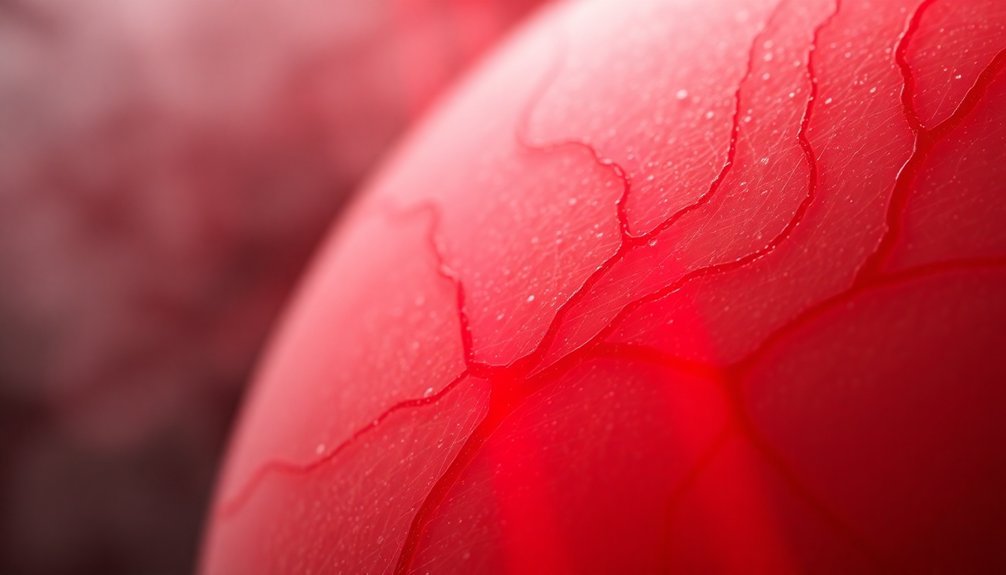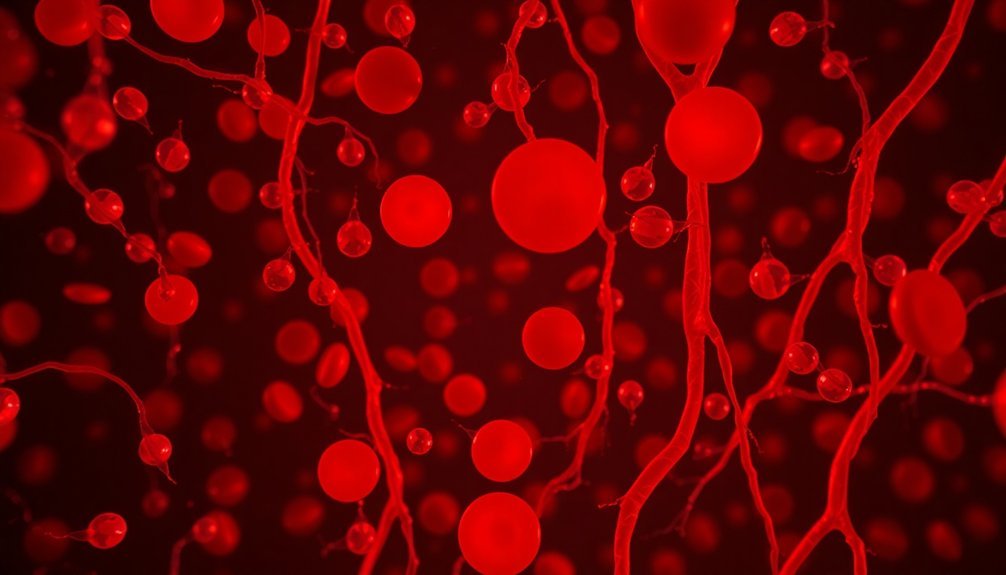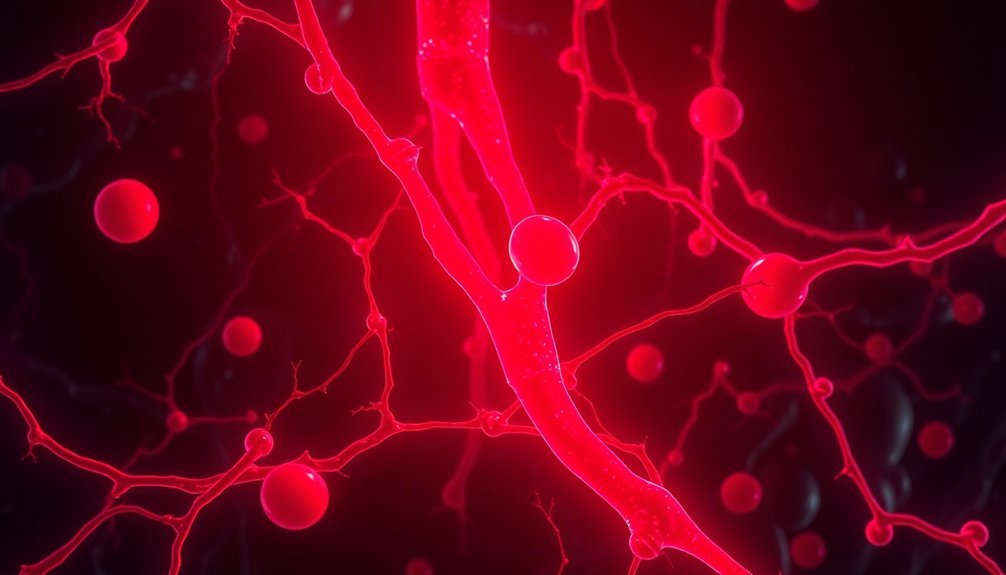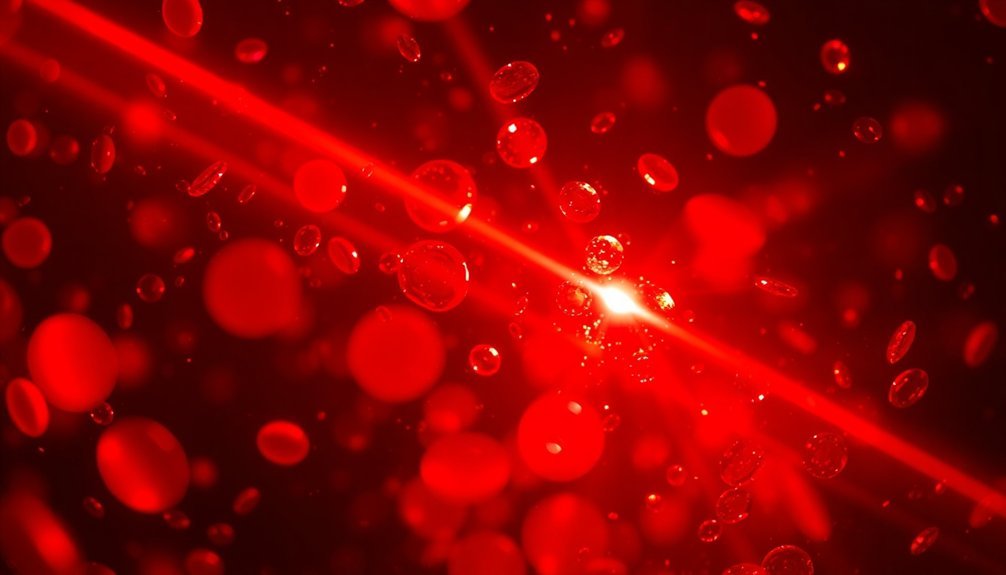Red light therapy supercharges your blood flow quality through five powerful mechanisms. Your body produces more nitric oxide, a vital molecule that helps blood vessels dilate and improves circulation throughout your system. You'll experience enhanced vessel dilation, allowing oxygen-rich blood to reach your tissues more effectively. The therapy reduces inflammation in your blood vessels while boosting your heart muscle's function through increased ATP production. Your entire blood delivery system becomes more efficient, with wider pathways and stronger flow. Discover how these interconnected benefits can transform your cardiovascular health from the inside out.
Nitric Oxide Production Boost

Through the natural production of nitric oxide (NO), your body regulates crucial processes like blood flow and muscle recovery. Red light therapy can enhance your NO production by dissociating bound nitric oxide, which improves your cellular energy production and supports better blood circulation throughout your body.
When you receive red light therapy, it activates specific enzymes called nitric oxide synthases (NOS). These enzymes convert L-arginine into NO, promoting blood vessel dilation and enhanced circulation. The therapy utilizes specific light wavelengths that have been shown to create a biphasic dose response in cells.
You'll benefit from improved muscle relaxation, faster recovery, and better cardiovascular health as NO helps regulate your blood pressure.
Your body uses different types of NOS enzymes, including endothelial (eNOS), neuronal (nNOS), and inducible (iNOS) forms. Each plays a unique role in maintaining your health, from supporting immune function to enhancing mood and cognition through increased blood flow to your brain.
However, you'll want to be cautious with red light therapy doses. While NO production is beneficial, excessive amounts can trigger inflammation and cellular damage. It's crucial to maintain balanced NO levels for ideal results, as this molecule can be both protective and harmful depending on its concentration.
Enhanced Vessel Dilation
Red light therapy drives powerful vessel dilation in your body through multiple mechanisms. When red and infrared light penetrates your skin, it triggers a cascade of effects that enhance your blood vessels' ability to expand and improve circulation.
Your blood vessels respond to this therapy through a carefully orchestrated process involving oxidative stress signals and increased nitric oxide production. Similar to blood flow restriction training, this process creates beneficial adaptations in your vascular system.
The process unfolds in your body through these key steps:
- Red light stimulates your mitochondria to produce controlled amounts of reactive oxygen species, which actually helps trigger beneficial vessel dilation.
- Your endothelial cells increase their production and release of nitric oxide, a vital molecule that tells blood vessels to relax.
- Special proteins like Rab11 become more abundant, helping your cells release vasodilatory substances more efficiently.
- The released nitric oxide transfers from your vessel walls to smooth muscle cells, causing them to relax and expand.
This enhanced vessel dilation directly improves your microcirculation, allowing more oxygen-rich blood to reach your tissues. You'll experience better blood flow throughout your body as the therapy affects both small capillaries and larger blood vessels, supporting ideal tissue oxygenation and nutrient delivery.
Reduced Inflammation Response

Inflammation's grip on your body loosens substantially with targeted light therapy. When you expose your body to red and near-infrared light, it triggers a powerful cellular response that directly combats inflammatory markers.
Your cells' mitochondria become energized, leading to decreased levels of reactive oxygen species and harmful prostaglandins that cause inflammation.
You'll experience faster tissue repair as the light penetrates deep into your muscles and joints. The therapy boosts your cells' production of ATP, your body's energy currency, which accelerates healing and reduces recovery times. Studies show this therapy can reduce recovery time by 50% compared to traditional treatments.
Your blood vessels respond by improving circulation to damaged areas, while your cells ramp up their production of protective antioxidants.
If you're dealing with chronic conditions like arthritis, back pain, or sports injuries, you'll find red light therapy particularly beneficial. It's a safe, non-invasive alternative to traditional treatments, backed by clinical studies showing significant pain reduction.
The therapy effectively treats both acute and chronic inflammation, even reaching deep enough to address neuroinflammation in the brain. Just remember to follow proper treatment guidelines to avoid any potential skin damage from high-intensity exposure.
Improved Heart Muscle Function
Light therapy's impact on heart health extends far beyond basic circulation. Research shows that red light therapy directly enhances your heart muscle's performance by targeting cellular energy production. When red light wavelengths reach your heart tissue, they stimulate mitochondria – your cells' power plants – to produce more ATP, the energy currency your heart needs to function at its best.
Studies on both animals and humans demonstrate that regular exposure to red light therapy can strengthen your heart's function in several key ways. The therapy has shown remarkable results in reducing inflammation after heart attacks.
- Boosts ATP synthesis in heart cells, giving your cardiac muscles more energy for efficient contractions and improved pumping ability
- Regulates your heart's circadian rhythm through the PER2 gene, which helps protect heart tissue from damage and improves overall cardiovascular health
- Reduces triglyceride levels in your blood while enhancing metabolic function, leading to better heart health
- Inhibits excessive collagen buildup in heart tissue, helping maintain proper cardiac structure and function
These benefits are achievable through short, focused therapy sessions lasting less than 15 minutes. Your heart's mitochondria respond quickly to the light exposure, initiating immediate improvements in cellular function and energy production.
Better Blood Delivery System

The blood delivery system benefits from three key mechanisms when exposed to red light therapy. First, it stimulates nitric oxide production, causing your blood vessels to dilate and expand, creating wider pathways for blood flow. Second, it enhances your cells' mitochondrial function, boosting energy production that supports vessel health. Third, it reduces inflammation that could otherwise restrict blood movement through your vessels.
You'll experience better oxygen and nutrient delivery throughout your body as these mechanisms work together. This improved circulation helps heal injuries, supports muscle recovery, and maintains overall tissue health. For those with conditions like peripheral artery disease or diabetic neuropathy, red light therapy can be particularly beneficial in improving blood flow to affected areas.
| Mechanism | Primary Effect | Health Benefit |
|---|---|---|
| Nitric Oxide | Vessel Dilation | Enhanced Blood Flow |
| Mitochondrial Boost | Increased Energy | Better Cell Function |
| Anti-inflammatory | Reduced Swelling | Improved Circulation |
| Combined Effect | Optimized Delivery | Faster Healing |
These improvements in your blood delivery system create a foundation for better overall health, supporting everything from wound healing to chronic condition management.
Frequently Asked Questions
How Long Does It Take to See Improvements in Circulation After Starting Therapy?
You'll notice immediate circulation benefits after your first session, with visible improvements in 1-2 weeks. For significant, lasting results in chronic conditions, continue treatments for 4-12 weeks while maintaining consistent sessions.
Can Red Light Therapy Interact Negatively With Blood Pressure Medications?
While interactions are generally minimal, you shouldn't use red light therapy within 5 days of taking blood pressure medications. Always consult your healthcare provider first, as some medications can cause photosensitivity reactions.
What Areas of the Body Are Best to Target for Maximum Circulation Benefits?
You'll get the best circulation benefits by targeting large muscle groups like your legs, chest, and torso. Don't forget your abdomen – it's vital for blood flow throughout your entire body.
Is Red Light Therapy Safe During Pregnancy for Improving Blood Circulation?
Yes, you can safely use red light therapy during pregnancy to improve circulation, but don't apply it to your abdomen. Always consult your OBGYN first and use proper eye protection during treatments.
How Often Should Red Light Therapy Sessions Be Scheduled for Optimal Results?
You'll get the best results by scheduling red light therapy 3-5 times weekly, with sessions lasting 10-30 minutes. Start with shorter durations and gradually increase. Don't exceed daily use to prevent overexposure.
In Summary
You'll experience notable improvements in your cardiovascular health when you incorporate red light therapy into your routine. By boosting nitric oxide, expanding your blood vessels, and reducing inflammation, you're giving your heart the support it needs. You're also enhancing your blood delivery system and strengthening your heart muscle. Consider adding this natural, non-invasive treatment to optimize your blood flow and overall circulatory wellness.





Leave a Reply